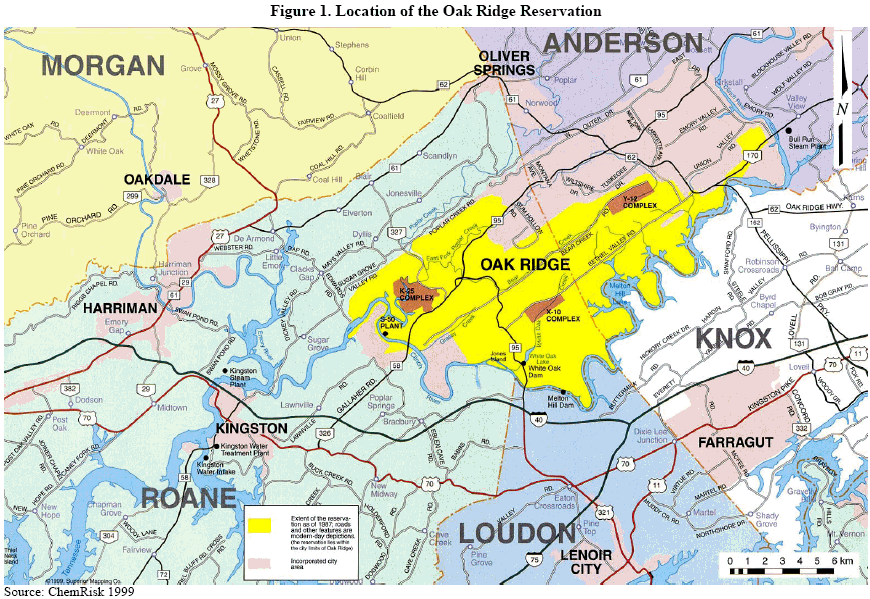The EEOICPA was passed in 2000. It provides compensation to workers who became ill as a result of their employment manufacturing nuclear weapons in the USA, as well as their spouses, children, and grandchildren.
Are you eligible for compensation? If you or a family member worked at this or another AWE or DOE facility and became ill, you may be entitled to compensation of up to $400K plus medical benefits. Call EEOICPA Counsel Hugh Stephens at 1-855-548-4494 or fill out our free claim evaluation, We can help even if you’ve already filed, even if your claim was denied!
Here, we have compiled publicly available information and documentation about the facilities covered by the Act to clarify how their activities relate to the Energy Employees Occupational Illness Compensation Program Act.
Oak Ridge Gaseous Diffusion Plant (K-25)
Oak Ridge Institute for Science Education (ORISE)
Oak Ridge National Laboratory (X-10)
Office of Scientific and Technical Information (OSTI)
S-50 Oak Ridge Thermal Diffusion Plant
 _____________________________________________________________________________
_____________________________________________________________________________
Oak Ridge Gaseous Diffusion Plant (K-25)
Also Known As: East Tennessee Technology Park (ETTP)
State: Tennessee
Location: Oak Ridge
Time Period: 1943-1987; 1988-present (remediation)
Facility Type: Department of Energy
Facility Description: The K-25 gaseous diffusion plant was built as part of the World War II Manhattan Project to supply enriched uranium for nuclear weapons production. Construction of K-25 started in 1943. It was the first diffusion facility for large-scale separation of uranium-235. It became was fully operable by August 1945. Additional buildings involved in the enrichment process were operable by 1956. Along with the plants in Paducah, KY, and Portsmouth, OH, the site was used primarily for the production of highly-enriched uranium for nuclear weapons until 1964.
From 1959 to 1969, focus shifted to the production of commercial-grade, low-enriched uranium. In 1985, declining demand for enriched uranium caused the enrichment process to be placed on standby. In 1987, the process was stopped permanently.
The Oak Ridge Gaseous Diffusion Plant was also a host for centrifuge facilities constructed as part of a program to develop and demonstrate uranium-enrichment technology. These facilities have also been shut down.
Throughout the course of its operations, the potential for beryllium exposure existed at this site, due to beryllium use, residual contamination, and decontamination activities.
Since 1988, the primary DOE mission at K-25 has been remediation, though on-site DOE contractors and sub-contractors continue to provide on-site services which are covered under EEOICPA. Also during this time, DOE paid for the construction of the Toxic Substances Control Act. (TSCA) incinerator which disposed of certain regulated wastes, much of which originated at various DOE facilities. In 1997 the name of the facility was changed to the East Tennessee Technology Park (ETTP) to reflect its changing nature. However, during this period of remediation, the process of privatization of K-25 into the ETTP was ongoing. This privatization effort involved leasing portions of the premises out to private industry to conduct their own business there. These private businesses and their employees are not covered under the EEOICPA.
SITE-WIDE CONTRACTORS: URS/CH2M Oak Ridge LLC (UCOR)(2011-present); Bechtel Jacobs (1998–2011); Lockheed Martin Energy Systems, Inc. (1994-1998); Martin Marietta Energy Systems, Inc. (1984-1994); Union Carbide & Carbon Corp. (1943-1984).
TSCA INCINERATOR for design, construction and operation: constructed by DOE in 1984 under Martin Marietta Energy Systems (MMES) (1984- 1988); operated by Lockheed Martin Energy Systems (LMES) (1988 to 12/18/1997); BJC (12/18/1997-9/30/2011); UCOR D&D (2011-present).
REMEDIATION CONTRACTORS: BNFL (British Nuclear Fuels Limited) was the DOE prime contractor for the complete D&D of three buildings (8/25/1997-9/30/2004).
Listing:
Oak Ridge Gaseous Diffusion Plant (K-25) is listed as a Department of Energy (DOE) site under the EEOICPA.
Classes:
Gaseous Diffusion Plants–employees who worked at least 250 days before February 1, 1992, at a gaseous diffusion plant in Paducah, Kentucky; Portsmouth, Ohio; or Oak Ridge, Tennessee and who were or could have been monitored in those jobs using dosimetry badges
Note: The SEC was established by The Act. The K-25 Site was one of the classes that Congress included when The Act was signed.
Compensation:
As of 08/30/2015, the total compensation paid under Parts B and E of the EEOICPA, including medical compensation, for workers suffering from the effects of having worked at the Oak Ridge Gaseous Diffusion Plant (K-25) is $1,387,295,167.
Oak Ridge Gaseous Diffusion Plant (K-25) Workers:
If you or your parent worked at this or any other DOE or AWE facility and became ill, you may be entitled to compensation of up to $400K plus medical benefits from the US Department of Labor. Call EEOICPA Counsel Hugh Stephens at 1-855-EEOICPA (336-4272) or fill out the form to the right, whether your claim has been accepted or denied.
We can help with all OWCP (Federal Workers Compensation) claims, impairments, wage loss and health care. 2495 Main Street, Suite 442 Buffalo, NY.
Videos:
A brief history of K-25 prepared by the DOE can be seen below:
Along with a bit of the destruction of K-25:
_______________________________________________________________________________
Oak Ridge Hospital
State: Tennessee
Location: Oak Ridge
Time Period: 1943-1959
Facility Type: Department of Energy
Facility Description: Originally a US Army Hospital for the Manhattan Project workers, this facility was operated for the AEC by Roane-Anderson Co. In 1959, ownership of the hospital was privatized and its operation taken over by the Oak Ridge Hospital of the Methodist Church.
Listing:
Oak Ridge Hospital is listed as a Department of Energy (DOE) site under the EEOICPA.
Classes:
All employees of the Department of Energy, its predecessor agencies, and its contractors and subcontractors who worked in any location at the Oak Ridge Hospital in Oak Ridge, Tennessee, from May 15, 1950 through December 31, 1959, for a number of work days aggregating at least 250 work days or in combination with work days within the parameters established for one or more other classes of employees in the SEC.
Compensation:
As of 08/30/2015, the total compensation paid under Parts B and E of the EEOICPA, including medical compensation, for workers suffering from the effects of having worked at Oak Ridge Hospital is $8,405,858.
Oak Ridge Hospital Workers:
If you or your parent worked at this or any other DOE or AWE facility and became ill, you may be entitled to compensation of up to $400K plus medical benefits from the US Department of Labor. Call EEOICPA Counsel Hugh Stephens at 1-855-EEOICPA (336-4272) or fill out the form to the right, whether your claim has been accepted or denied.
We can help with all OWCP (Federal Workers Compensation) claims, impairments, wage loss and health care. 2495 Main Street, Suite 442 Buffalo, NY.
________________________________________________________________________________
Oak Ridge Institute for Science Education (ORISE)
Also Known As: Oak Ridge Associated Universities (ORAU), Oak Ridge Institute for Nuclear Studies
State: Tennessee
Location: Oak Ridge
Time Period: 1946-present
Facility Type: Department of Energy
Facility Description: Oak Ridge Associated Universities (ORAU) is a university consortium leveraging the scientific strength of 105 major research institutions to advance science and education by partnering with national laboratories, government agencies, and private industry. 1966, ORINS became known by the name of the operating contractor, ORAU. In the early 1990s, the name was changed to ORISE, the Oak Ridge Institute for Science Education. ORAU manages ORISE for the U.S. Department of Energy. ORISE focuses on scientific initiatives to research health risks from occupational hazards, assess environmental cleanup, respond to radiation medical emergencies, support national security and emergency preparedness, and educate the next generation of scientists.
The South Campus Facility was originally established to study accidental irradiation of cattle during testing of the first atomic bomb near Alamogordo, New Mexico. This facility was also known as the Agricultural Research Laboratory and Farm and then as the Comparative Animal Research Laboratory (CARL). It was operated by the University of Tennessee for the Atomic Energy Commission until it was assigned to ORAU and ORISE in 1981.
CONTRACTOR: Oak Ridge Associated Universities (1946-present)
Listing:
ORISE is listed as a Department of Energy (DOE) site under the EEOICPA.
Classes:
The SEC classes for ORISE include employees of the DOE predecessor agencies and their contractors or subcontractors who were monitored or should have been monitored while working at the Oak Ridge Institute of Nuclear Studies (ORINS) Cancer Research Hospital from May 15, 1950, through December 31, 1963, and who were employed for a number of work days aggregating at least 250 work days or in combination with work days within the parameters established for other classes of employees included in the SEC.
History:
The Oak Ridge National Laboratory (ORNL) is located near Knoxville, Tennessee and was established in 1942 by the Army Corps of Engineers as the Clinton Engineer Works as part of the Manhattan Project. It was later renamed the Oak Ridge National Laboratory. The X-10 reactor on site extracted plutonium from enriched uranium to be used in nuclear weapons. After the need for plutonium decreased following the end of WWII, ORNL was used for scientific research and today is involved in many different areas of research including physics, energy, biology, and high performance computing. As of 2012, more than 4000 individuals carry out research at ORNL.
Compensation:
As of 08/30/2015, the total compensation paid under Parts B and E of the EEOICPA, including medical compensation, for workers suffering from the effects of having worked at the Oak Ridge Institute for Science Education (ORISE) is $16,940,534.
Oak Ridge Institute for Science Education (ORISE) Workers:
If you or your parent worked at this or any other DOE or AWE facility and became ill, you may be entitled to compensation of up to $400K plus medical benefits from the US Department of Labor. Call EEOICPA Counsel Hugh Stephens at 1-855-EEOICPA (336-4272) or fill out the form to the right, whether your claim has been accepted or denied.
We can help with all OWCP (Federal Workers Compensation) claims, impairments, wage loss and health care. 2495 Main Street, Suite 442 Buffalo, NY.
________________________________________________________________________________
Oak Ridge National Laboratory (X-10)
Also Known As: Clinton Laboratories, X-10, Holifield National Laboratory
State: Tennessee
Location: Oak Ridge
Time Period: 1943-present
Facility Type: Department of Energy
Facility Description: During the Manhattan project, the Oak Ridge National Laboratory (ORNL) site was used by the University of Chicago Metallurgical Laboratory to construct the first pile semiworks – a test plant that would move the plutonium product process from the research stage to large scale production. DuPont began construction of the test pile, the X-10 reactor in March 1943 and was ready for operations by January 1944. A research facility designated as the Clinton Laboratories was built during the war to support X-10 reactor activities and included chemistry, health and engineering divisions.
After the war, the laboratory was transformed from a war production facility to a nuclear research center and changed its name to Oak Ridge National Laboratory in 1948. The Laboratory’s research role in the development of nuclear weapons decreased over time, but the scope of its work expanded to include production of isotopes, fundamental hazardous and radioactive materials research, environmental research, and radioactive waste disposal.
Throughout the course of its operations, the potential for beryllium exposure existed at this site, due to beryllium use, residual contamination, and decontamination activities.
CONTRACTORS: University of Chicago (1943-1945); Monsanto Chemical (1945-1947); Union Carbide and Carbon Corp. (1948-1984); Martin Marietta Energy Systems (1984-1994); Lockheed Martin Energy Research Corp. (1994-1998); UT Battelle (2000-present)
Listing:
Oak Ridge National Laboratory (X-10) is listed as a Department of Energy (DOE) site under the EEOICPA.
Classes:
All employees of the Department of Energy, its predecessor agencies, and their contractors and subcontractors who worked in any area at the Oak Ridge National Laboratory (X-10) in Oak Ridge, Tennessee, from June 17, 1943, through July 31, 1955, for a number of work days aggregating at least 250 work days, occurring either solely under this employment, or in combination with work days within the parameters established for one or more other classes of employees in the Special Exposure Cohort
(Note: This class was established by Petition 189)
Compensation:
As of 08/30/2015, the total compensation paid under Parts B and E of the EEOICPA, including medical compensation, for workers suffering from the effects of having worked at the Oak Ridge National Laboratory (X-10) is $662,660,201.
Oak Ridge National Laboratory (X-10) Workers:
If you or your parent worked at this or any other DOE or AWE facility and became ill, you may be entitled to compensation of up to $400K plus medical benefits from the US Department of Labor. Call EEOICPA Counsel Hugh Stephens at 1-855-EEOICPA (336-4272) or fill out the form to the right, whether your claim has been accepted or denied.
We can help with all OWCP (Federal Workers Compensation) claims, impairments, wage loss and health care. 2495 Main Street, Suite 442 Buffalo, NY.
History:
Since its operations began in 1943, the mission of ORNL has been to conduct research and development (R&D) and production missions in support of DOE and its predecessor agencies. (ORNL has also been known as X-10, Clinton Laboratories, and, briefly, Holifield National Laboratory.) Much of the earliest site work was devoted to the development and operation of the original plutonium production reactor and associated chemical separation facility to test the larger production reactors that were being built on the Hanford Site. The Graphite Reactor produced gram quantities of plutonium and later fission products [e.g., radioactive lanthanum (RaLa)]; other types of radioactive materials were separated in other site facilities. Waste control technologies during early site operations were in their infancy, and much of the current knowledge of transport of radionuclides in the environment was obtained during this time. The ability to detect, identify, and quantify radiation types and exposures was progressing along with new technologies being discovered in radioisotope production. Much of the information gained during the early years at ORNL was used for the design of future U.S. Atomic Energy Commission (AEC)/DOE facilities and detection systems. Waste radioactive material was released from early site operations as gaseous, liquid, and solid effluents with little or no pretreatment. Methods were later developed to capture many of the contaminants at their source and to reduce overall plant emissions. In some cases, this increased direct exposures to individuals in the immediate area and created locations in which incidents and spills occurred.
Major historic operations and processes at ORNL include:
; The operation of the Graphite Reactor for producing plutonium and other radioisotopes
; The development and refinement of chemical processes to separate plutonium, uranium, and thorium from irradiated fuel
; Chemical separation of RaLa from irradiated fuel slugs for use in implosion dynamics studies at Los Alamos National Laboratory
; Operation of facilities for the separation, packaging, and distribution of radioisotopes for government and commercial use
In addition, ORNL developed new reactor technologies. The Laboratory tested different reactor designs (pool, pressurized-water, boiling-water, liquid-metal, gas-cooled) that were either scrapped or developed further elsewhere. Reactors operated at ORNL include the Low-Intensity Test Reactor (LITR), Critical Experiments Facility [CEF at the Y-12 National Security Complex (Y-12)], Bulk Shielding Reactor (BSR)/Pool Critical Assembly (PCA), Oak Ridge Research Reactor (ORR), Tower Shielding Reactor (TSR), Health Physics Research Reactor (HPRR), Homogeneous Reactor Experiment (HRE), Aircraft Nuclear Propulsion (ANP) Program, the High Flux Isotope Reactor (HFIR), and the Molten Salt Reactor Experiment (MSRE).
In 1947, several ORNL divisions moved to Y-12. These divisions conducted research in biological sciences, the production of stable isotopes in the calutron units, and engineering technology.
Videos:
A brief history of ORNL can be seen below:
A different take on the activities at ORNL can be seen in this video:
________________________________________________________________________________
Office of Scientific and Technical Information (OSTI)
State: Tennessee
Location: Oak Ridge
Time Period: 1957 – Present
Facility Type: Department of Energy
Facility Description: The Office of Scientific and Technical lnformation was created to serve as a federal government repository for all technical reports pertaining to the Department of Energy and its predecessor agencies.
*The Department of Energy is responsible for the collection, preservation, and dissemination of sponsored R&D results that are the outcomes of R&D projects or other funded activities at DOE labs and facilities nationwide, as well as grantees at universities and other institutions. This scientific and technical information (STI) is produced and published in various formats, including technical reports, scientific/technical conference papers and presentations, theses and dissertations, journal citations, manuscripts and published articles, e-prints, videos, software, patents, and datasets.
The Office of Scientific and Technical Information (OSTI), a unit of the Office of Science, fulfills agency-wide responsibilities to collect, preserve, and disseminate STI emanating from DOE R&D activities. The Department has carried out this function since the 1940s and is legislatively mandated to do so, most recently in the Energy Policy Act of 2005, which reads:
“The Secretary, through the Office of Scientific and Technical Information, shall maintain within the Department publicly available collections of scientific and technical information resulting from research, development, demonstration, and commercial applications activities supported by the Department.”
OSTI also is responsible for providing public access to scholarly scientific publications resulting from DOE-funded research, and it manages the collection of all DOE STI through the collaborative DOE Scientific and Technical Information Program.
The OSTI mission is to advance science and sustain technological creativity by making R&D findings available and useful to DOE researchers and the public. The OSTI Catalogue of Collections provides information about all the DOE, U.S. government, and international science resources that OSTI maintains.
*Source
Listing:
Office of Scientific and Technical Information (OSTI) is listed as a Department of Energy (DOE) site under the EEOICPA.
Compensation:
As of 05/03/2015, the total compensation paid under Parts B and E of the EEOICPA, including medical compensation, for workers suffering from the effects of having worked at the Office of Scientific and Technical Information (OSTI) is $1,502,370.
Office of Scientific and Technical Information (OSTI) Workers:
If you or your parent worked at this or any other DOE or AWE facility and became ill, you may be entitled to compensation of up to $400K plus medical benefits from the US Department of Labor. Call EEOICPA Counsel Hugh Stephens at 1-855-EEOICPA (336-4272) or fill out the form to the right, even if your claim has been accepted or denied.
We can help with all OWCP (Federal Workers Compensation) claims, impairments, wage loss and health care. 2495 Main Street, Suite 442 Buffalo, NY.
________________________________________________________________________________
S-50 Oak Ridge Thermal Diffusion Plant
State: Tennessee
Location: Oak Ridge
Time Period: 1944-1951
Facility Type: Department of Energy
Facility Description: The S-50 Plant at Oak Ridge was constructed in 1944 to enrich uranium feed material for the Y-12 electromagnetic facility using a liquid thermal diffusion process. The process was originally developed at theNaval Research Laboratory in Washington, DC, and tested on a pilot plant level at the Philadelphia Naval Shipyard. Located near the K-25 gaseous diffusion facility, the S-50 Plant operated for a limited period during 1944- 1945. The plant was closed in September 1945 because the thermal diffusion process was not as efficient as the gaseous diffusion.
The S-50 plant was reopened in 1946 as part of the joint Air Force/AEC project to investigate the possibility of developing a nuclear-powered airplane. This project, known as Nuclear Energy for the Propulsion of Aircraft (NEPA), was housed at S-50 and the contractor was the Fairchild Engine and Aircraft Corporation. Fairchild’s NEPA Division at S-50 conducted a number of experiments involving beryllium powder during the time period 1946-1951.
Listing:
S-50 Oak Ridge Thermal Diffusion Plant is listed as Department of Energy (DOE) site under the EEOICPA.
Classes:
Employees of the DOE predecessor agencies and their contractors and subcontractors who were monitored or should have been monitored while working at the S-50 Oak Ridge Thermal Diffusion Plant working for a number of work days aggregating at least 250 work day during the period from July 9, 1944, through December 31, 1951, or in combination with work days within the parameters established for one or more other classes of employees in the SEC.
Compensation:
As of 08/30/2015, the total compensation paid under Parts B and E of the EEOICPA, including medical compensation, for workers suffering from the effects of having worked at the S-50 Oak Ridge Thermal Diffusion Plant is $8,904,608.
S-50 Oak Ridge Thermal Diffusion Plant Workers:
If you or your parent worked at this or any other DOE or AWE facility and became ill, you may be entitled to compensation of up to $400K plus medical benefits from the US Department of Labor. Call EEOICPA Counsel Hugh Stephens at 1-855-EEOICPA (336-4272) or fill out the form to the right, whether your claim has been accepted or denied.
We can help with all OWCP (Federal Workers Compensation) claims, impairments, wage loss and health care. 2495 Main Street, Suite 442 Buffalo, NY.
* SITE DESCRIPTION:
The S-50 Liquid Thermal Diffusion Plant was a wartime uranium enrichment facility constructed in 1944 adjacent to the K-25 facility in Oak Ridge, Tennessee by H. K. Ferguson Company and operated by Fercleve Corporation, a wholly owned subsidiary of H. K. Ferguson Company that was organized for the sole purpose of operating the Plant. Groundbreaking for the facility was on July 9, 1944, and construction was complete on October 31, 1944. The main process building dimensions were 522 ft long by 62 ft wide by 75 ft high; the building had a concrete floor and foundation, and steel frames, sides, and roof (MED 1947). Uranium enrichment began on September 16, 1944, before construction was complete. Thermal diffusion operations shut down on September 9, 1945 (DOE 2005).
There was a tremendous amount of emphasis placed on high production output at this facility. Processed uranium from the Plant was used as feed material for the Y-12 facility, where it was further enriched; some of this material was used in the bomb dropped over Hiroshima (“Little Boy”). Operations at S-50 generally continued around the clock. The number of individuals employed by Fercleve Corporation reached a maximum of more than 1,500 in April 1945 (MED 1947).
Feed material came from Harshaw Chemical Company of Cleveland, Ohio, in nickel shipping containers as uranium hexafluoride (UF6). The liquid thermal diffusion process at S-50 increased 235U enrichment from natural (0.71%) to 0.85% (MED 1947).
The process to enrich uranium at S-50 consisted of multiple columns, each of which contained three concentric pipes. High-pressure (1,000-psig) steam passed through the innermost nickel pipe, which was inside a copper pipe. UF6 was batch-charged into the gap between the nickel and copper pipes at about 1,500 psig. The nickel and copper pipes were inside the outermost steel pipe. Cold water passed between the steel pipe and the outer wall of the copper pipe. The enrichment process utilized convective flow, whereby the lighter 235U molecules tended to move upward along the hot nickel pipe wall while the heavier 238U molecules moved downward along the cold copper wall (MED 1947). A graph of the production output from S-50 (Percentage of Original Theoretical Maximum Output) showed the racks operated at less than 5% until January 1945, at which time the production increased gradually to a maximum of approximately 90% in June 1945 (MED 1947).
Losses of UF6 were common during S-50 operations, with UF6 often escaping into the air or cooling water (MED 1947). The losses usually resulted from internal or external breaks in columns or other parts of the process, which were caused by failure of the materials under the high operating pressures. Other losses resulted from improper handling of open connections and from operational mistakes due, in part, to the number of new employees at the facility and the emphasis on high production rates. From March through July 1945, monthly losses of UF6 ranged from 247 to 1,826 lb (DOE 2005). Accountability records showing losses for other months of operation are unavailable. The released UF6 would rapidly oxidize and form uranyl fluoride (UO2F2) (DOE 2005), which would either exhaust through the building roof or settle to the process building floor. Operators were required to have a gas mask on their persons at all times for emergencies (MED 1947).
The S-50 Plant ceased enrichment operation in September 1945, shortly after the war ended (MED 1947). The uranium enrichment process used at S-50 was unique in that it was the only production-scale liquid thermal diffusion facility ever built. S-50 closed because it had become evident that the liquid thermal diffusion process would not be competitive with the gaseous diffusion process.
Disassembly of the S-50 process equipment was done in the late 1940s, at which time it was removed from the main process building and transported to the K-25 Powerhouse Area, where it was stored for some time before being either salvaged or buried (DOE 2005).
*Source

















